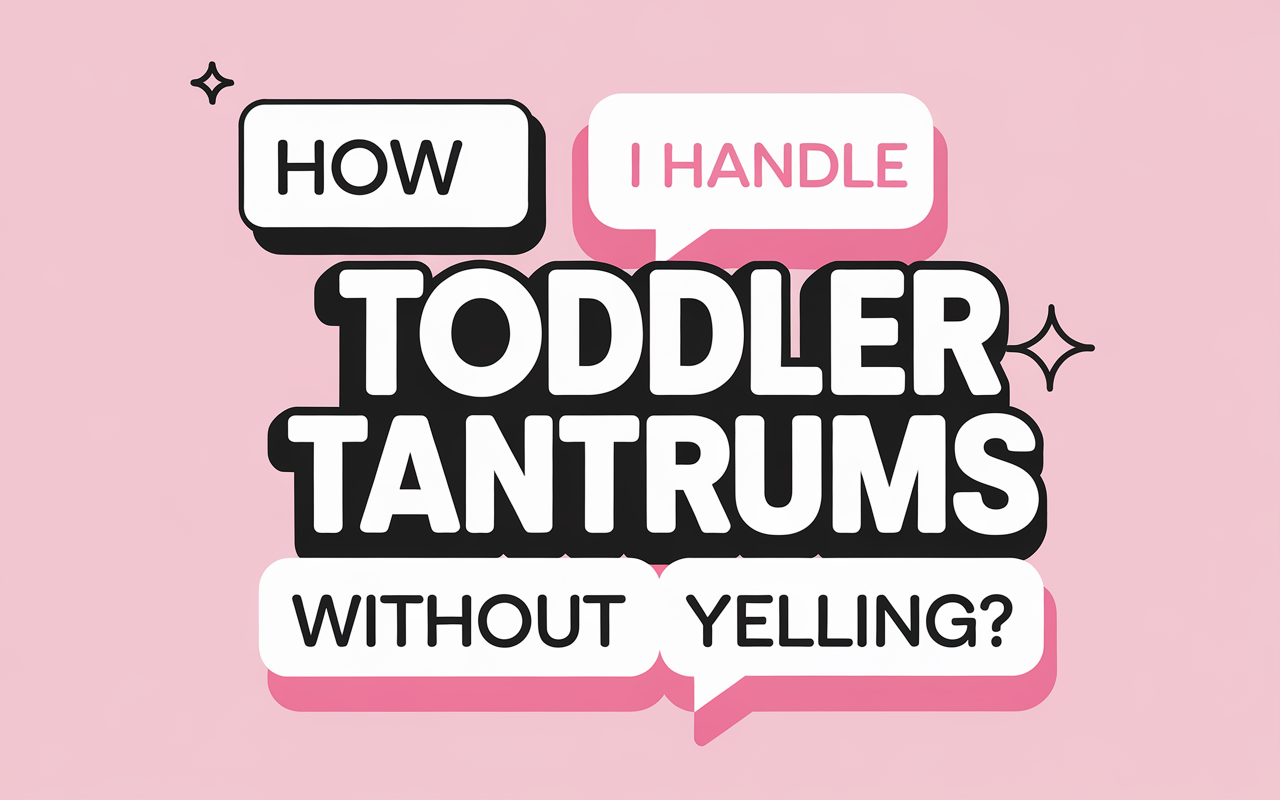The sound is unmistakable. The high-pitched shriek, the stiffened body, the sudden transformation of your sweet toddler into a tiny, raging force of nature. In that moment, as every head in the grocery store aisle swivels in your direction, your own internal storm begins to brew. Your heart pounds, your face flushes, and a single, primal urge rises: to yell. To just make it stop. If this sounds familiar, take a deep breath. You are not a bad parent. You are a human parent of a toddler, and you have come to the right place.
Handling toddler tantrums is one of the most challenging, exhausting, and humbling parts of parenting. Yelling might feel like a release in the moment, but we instinctively know it’s not the answer. It escalates the chaos, frightens our children, and leaves us riddled with guilt. This guide is your lifeline. We will dive deep into the science behind why tantrums happen, provide a clear, step-by-step plan for what to do in the heat of the moment, and equip you with powerful, proactive strategies to reduce their frequency and intensity. It’s time to trade yelling for understanding, and chaos for connection.
Your Roadmap to Calmer Parenting
The “Why”: Inside the Toddler Brain During a Tantrum
To stop seeing tantrums as a battle of wills, we must first understand what’s happening inside our child’s developing brain. A tantrum is not a calculated act of manipulation; it’s a neurological “lid flip.”
Upstairs Brain
(Logic, Planning, Self-Control)
OFFLINE!
Downstairs Brain
(Big Emotions, Fight/Flight)
IN CHARGE!
The Upstairs & Downstairs Brain
Think of the brain as a two-story house. The downstairs brain (the brainstem and limbic system) is primitive. It’s responsible for basic functions and big, raw emotions like fear and anger. It’s fully developed at birth.
The upstairs brain (the cerebral cortex, especially the prefrontal cortex) is the sophisticated, logical part. It’s responsible for planning, reasoning, emotional regulation, and self-control. Here’s the catch: this part of the brain is under massive construction until the mid-20s.
During a tantrum, your toddler’s downstairs brain completely hijacks their system. The connection to their logical upstairs brain goes “offline.” They are physically incapable of listening to reason, negotiating, or learning a lesson. Yelling at a child in this state is like yelling at a computer that has crashed. It doesn’t help it reboot; it just adds more chaotic energy.
Your New Job Description: The Calm Anchor
Our instinct is to be a disciplinarian, a fixer, or a negotiator during a tantrum. These roles are ineffective when the upstairs brain is offline. Your new job, and your most powerful role, is to be the Calm Anchor in your child’s emotional storm.
Imagine your child is a small boat tossed in a raging sea. They are scared and out of control. Yelling is like adding more wind and waves. Being an anchor doesn’t stop the storm, but it provides a steady, safe, and unmovable presence that lets the boat know it won’t be lost at sea. It communicates, without words: “This is a big, scary feeling, but I am here, and I will keep you safe until it passes.” Adopting this mindset is the first, most crucial step to handling tantrums without yelling.
The 4-C Method: Your In-the-Moment Action Plan
Okay, the tantrum is happening. Right here, right now. What do you actually do? Forget complex theories. Remember this simple, four-step process.
1. Calm Yourself First
You cannot be a calm anchor if you are also in a storm. Take one deep, slow breath. Unclench your jaw. Lower your shoulders. Remind yourself: “This is not an emergency. My child is having a hard time, not giving me a hard time.” Your calm is contagious.
2. Contain the Situation
Ensure safety. If your child is hitting, kicking, or in a dangerous place, calmly and silently move them. This isn’t punishment; it’s a safety measure. Say very little. “I’m moving you to keep you safe.” This might mean moving to a quiet corner, the car, or just holding their hands gently.
3. Connect Emotionally
Get down on their level. Use a soft, low voice. Acknowledge the feeling without judging the behavior. Use simple words. “You are so mad.” “You feel very sad we have to leave.” “It’s frustrating when the blocks fall.” This is called validation, and it’s magic. It tells their brain, “Someone gets it.”
4. Coach Later (Much Later)
Once the storm has completely passed and the upstairs brain is back online, you can offer a simple, brief teaching moment. “When you feel mad, you can stomp your feet or hit a pillow, but we don’t hit people.” Then move on. The real learning happens through connection, not lectures.
The Best Offense: Proactive Tantrum Prevention
The easiest tantrum to handle is the one that never happens. Many tantrums are not random; they are predictable responses to unmet needs or triggers. Become a detective and look for patterns. The most powerful tool for this is the acronym H.A.L.T.
Are they Hungry, Angry/Anxious, Lonely, or Tired?
A huge percentage of toddler meltdowns can be traced back to one of these four core states. Before you run errands or attempt a tricky transition, quickly scan this mental checklist:
- Hungry: A toddler’s blood sugar can drop rapidly, leading to “hanger.” Always have snacks on hand. Offer small, healthy meals and snacks regularly throughout the day.
- Angry/Anxious: Toddlers have very little control over their lives, which can be frustrating. Offer simple, appropriate choices throughout the day (“Do you want the red cup or the blue cup?”) to fill their “power” bucket. Prepare them for transitions (“In five minutes, we will leave the park”).
- Lonely: In our busy lives, it’s easy to go hours without giving our child focused, undivided attention. Just 10-15 minutes of “special time” where you put your phone away and get on the floor to play can fill their connection cup and prevent attention-seeking behavior.
- Tired: An overtired toddler is a ticking time bomb. Protect naps and ensure a consistent, early bedtime. A toddler who misses their sleep window will be flooded with cortisol and adrenaline, making sleep (and calm behavior) harder to achieve.
What to Actually Say: Your Parenting Scripts
Knowing what to say can be the hardest part. Here are some scripts to use in the heat of the moment and beyond. The tone is everything: keep it low, slow, and calm.
CONTEXT: Your toddler is melting down because you said “no” to a toy at the store.
Phase 1: Validation (Connecting with the feeling)
- “You really, really want that toy. It’s so hard to see something you want and not get it.”
- “You’re feeling so sad and mad that we can’t buy it today.”
- “I hear you. You’re shouting to show me how much you want it.”
Phase 2: Holding the Boundary (Calmly and kindly)
- “I know you want it. The answer is no. We are not buying that toy today.”
- “I see you’re disappointed. It’s okay to be disappointed. My decision isn’t changing.”
- “I’m going to help you. I will keep you safe while you have this big feeling.”
CONTEXT: Your toddler is frustrated because they can’t get their shoes on.
Phase 1: Sports-casting & Validating
- “You are working so hard to put that shoe on. It’s not going! That is so frustrating.”
- “You’re pushing and pushing, and your face is telling me you’re getting angry.”
- “It’s okay to feel frustrated. This is tricky.”
Phase 2: Offering Help (Not doing it for them)
- “Would you like me to hold the shoe open while you push your foot in?”
- “I can see you’re struggling. I’m here if you need a little help.”
- “Let’s take a deep breath together. Okay, want to try one more time?”
Common Traps to Avoid (That Lead to Yelling)
Certain reactions, while instinctive, almost always make tantrums worse and increase the likelihood that you’ll end up yelling.
-
Trying to Reason or Lecture.
Their logical brain is offline. Saving your explanations for later when they are calm is far more effective.
-
Bribing or Giving In.
“If you stop crying, you can have a cookie.” This teaches them that tantrums are a powerful tool to get what they want. It stops the tantrum now but guarantees more in the future.
-
Punishing or Using Time-Outs.
A tantrum is a cry for help. Isolating or punishing a child in this state of distress deepens their fear and communicates that their big feelings are “bad” and unacceptable to you.
-
Dismissing or Minimizing Their Feelings.
“You’re fine,” “Stop crying, it’s not a big deal.” This invalidates their experience and tells them their feelings don’t matter, which can damage your connection.
You Can’t Pour From an Empty Cup: Your Plan for When YOU Feel Like Yelling
Let’s be honest: sometimes the tantrum is manageable, but our own stress levels are not. To be a calm anchor, you need to manage your own internal weather. This is not selfish; it’s essential.
Develop a “Pause Plan”
When you feel the rage building, have a pre-planned action. It could be placing your hand on your heart, taking three deliberate breaths, or repeating a mantra like “This is a moment in time.” The goal is to create a tiny space between the trigger and your reaction.
Tap Out if Possible
If another adult is present, use a code phrase like “I need to tap out” or “I need a minute.” There is no shame in stepping away for 60 seconds to splash water on your face or breathe in another room while your partner takes over. It’s modeling healthy self-regulation.
Practice the “Do-Over”
You will yell. You are human. When it happens, the most powerful tool is a genuine apology and a “do-over.” Later, when everyone is calm, say, “I’m sorry I yelled. I was feeling frustrated. Let me try that again.” This models accountability and repair, which are invaluable life skills.
Frequently Asked Questions
This is the ultimate test. Your goal is the same: safety and calm. Your first move is to calmly remove your child from the situation. Go to your car, a quiet hallway, or a family restroom. Deal with the tantrum there, away from judging eyes. Abandon your shopping cart if you have to. Protecting your child’s dignity and your connection is more important than groceries.
While some distinguish between a goal-oriented “tantrum” and an overload-induced “meltdown,” for a toddler, the line is blurry. The neurological state is the same: the upstairs brain is offline. Therefore, the approach of being a calm, co-regulating anchor works for both. Don’t get bogged down in semantics; focus on the compassionate response.
Tantrums are a normal part of development, peaking between ages 2 and 3. However, you might consider talking to a pediatrician or child development specialist if the tantrums are extremely frequent (multiple times a day, every day), last for very long periods (over 25 minutes regularly), involve self-harm, or if you feel consistently overwhelmed and unable to cope.
The Long Game: Building Emotional Intelligence
Handling tantrums without yelling is not about finding a magic trick to make your child “behave.” It’s a long-term investment in their emotional intelligence and your relationship. Every time you meet their storm with your calm, you are literally helping to build the neural pathways for self-regulation in their brain. You are teaching them that all feelings are acceptable, that they are loved unconditionally even at their worst, and that they can count on you to be their safe harbor.
This path requires immense patience and practice. You will have good days and terrible, no-good, very bad days. But by choosing connection over correction, and empathy over anger, you are giving your child—and yourself—a gift that will last a lifetime.
Disclaimer: This content was automatically imported from a third-party source via RSS feed. The original source is: https://babieblue.com/how-to-handle-toddler-tantrums-without-yelling/. xn--babytilbehr-pgb.com does not claim ownership of this content. All rights remain with the original publisher.



